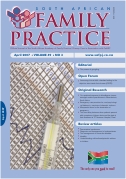Occupational exposure to bloodborne viruses amongst medical practitioners in Bloemfontein, South Africa
Keywords:
Needlestick injuries, bloodborne viruses, occupational exposure outcome
Abstract
Background The possibility of occupational exposure to bloodborne viruses such as HIV, hepatitis B virus (HBV) and hepatitis C virus (HCV) is an everyday reality to health care workers. This study reports on doctors’ extent and outcome of exposure to bloodborne viruses in Bloemfontein. Methods A descriptive study was done. Doctors (n=441) actively involved in public and/or private medical practice were requested to anonymously complete a questionnaire regarding occupational exposure to bloodborne viruses (HIV, HBV, and HCV). Results A response rate of 51.7% was obtained. More than half (54.2%, 95% CI [ 47.7% ; 60.5% ]) of respondents were exposed to bloodborne viruses; 48.3% occurring with HIV positive patients and 4.3% with known HBV positive patients, and no positive HCV patients. After exposure occurred, 68.9% of patients were tested for HIV, 10.9% for HBV and only 4.2% for HCV infection. The frequency of serological testing for doctors immediately after exposure was 65.3% for HIV, 21.7% for HBV and 8.2% for HCV. No seroconversion to HIV or HCV was reported, while two seroconversions to HBV were reported. Most exposures occurred as a result of needle stick injury (85%) and occurred in the operating theatre during procedures 59.3%. The majority (59.8%) of exposed doctors did not take any prophylactic treatment and those who did, did not always complete the treatment Conclusions The risk of seroconversion to HIV after occupational exposure was as expected, while seroconversion to HBV was less than expected. The lack of adequate follow up serological testing after occupational exposure is alarming. It is the responsibility of the occupationally exposed doctor to adequately comply with prophylactic measures and undergo serological testing to ensure the least possible risk of contracting infection from a bloodborne virus.
Published
2007-04-04
Section
Original Research
By submitting manuscripts to SAFP, authors of original articles are assigning copyright to the South African Academy of Family Physicians. Copyright of review articles are assigned to the Publisher, Medpharm Publications (Pty) Ltd, unless otherwise specified. Authors may use their own work after publication without written permission, provided they acknowledge the original source. Individuals and academic institutions may freely copy and distribute articles published in SAFP for educational and research purposes without obtaining permission.

